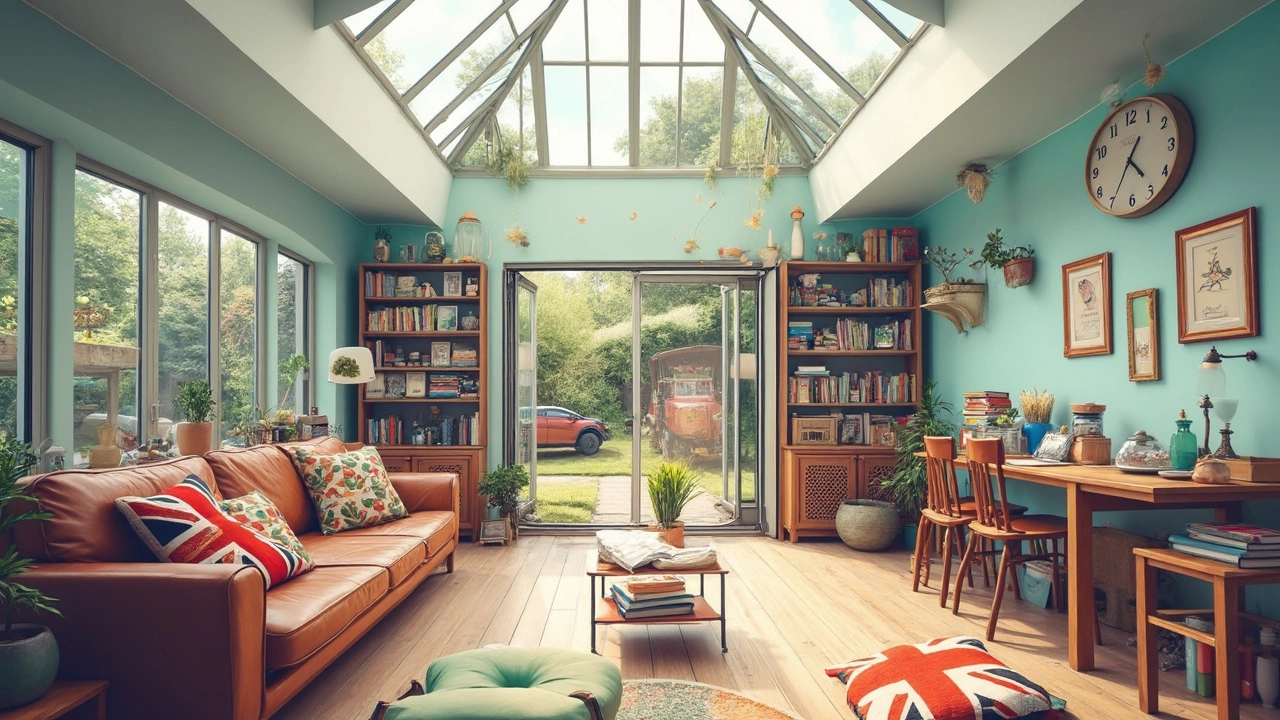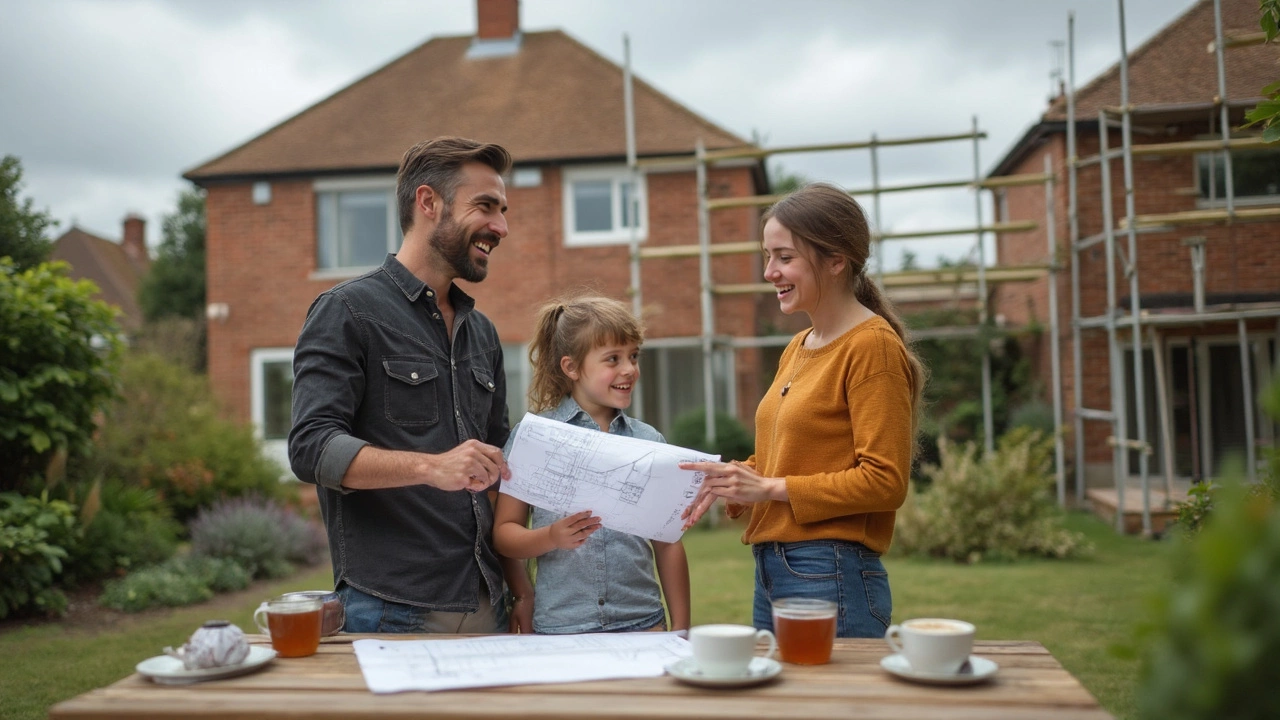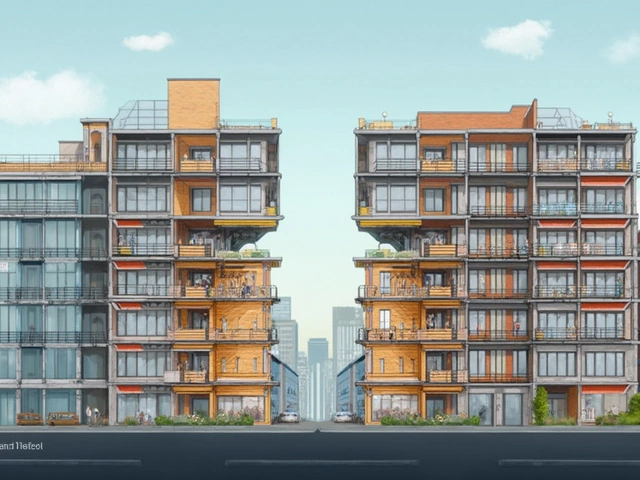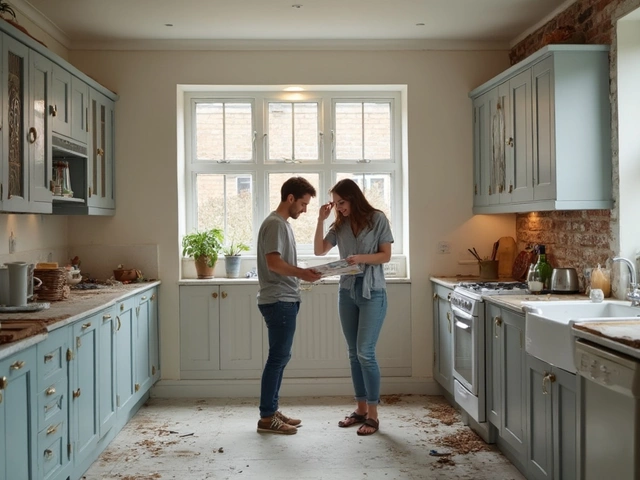If your living room feels tighter every year or you're sick of arguing over whose stuff goes where, you're definitely not alone. Loads of families hit this wall—especially when kids like Sawyer start bringing home mountains of sports gear and random art projects. So, the big question: Is sticking an extension onto your house the smart move, or will it just swallow a chunk of your savings for not much gain?
Extensions sound great in theory: extra bedroom, bigger kitchen, maybe that home office you keep promising you'll use. But here’s the kicker—DIY blogs and glossy home shows rarely mention the actual bumps in the road. Between council approvals, finding a builder who doesn’t ghost you, and the sneaky costs that show up halfway through, there’s a lot to consider.
The real value isn’t just the new square meters. You need to figure out what matters more: your daily comfort and future-proofing your family's needs, or keeping a tight hold on your budget and maybe just reworking what you’ve got. We’ll take a look at where your money goes, the best tricks for dodging cash-draining mistakes, and help you decide if this is a ride you want to take or a headache to avoid.
- Why Consider a House Extension?
- Crunching the Real Costs
- How Much Value Can You Really Add?
- Hidden Pitfalls: What Nobody Tells You
- Tips for Making It Work (And Saving Cash)
- Is a House Extension Worth It for You?
Why Consider a House Extension?
Unless you’re itching to move or you’ve got a hidden attic that could squeeze in one more kid, extending your place can look like the best way out. Most families need more space eventually. Between growing kids, work-from-home days, and everyone wanting their own corner, it gets cramped fast. More living area isn’t just about rubbing elbows less, though. Sometimes it’s about adding real function—a bigger kitchen, a proper office, or a playroom that saves your sanity.
Space isn’t the only draw. A solid house extension can bump up your property value. Recent UK stats showed that a well-planned extension can add up to 23% to the value of your place, while in the US, adding a primary suite or open-plan living space often brings a big return at resale. UK finance site MoneySuperMarket even claims, “An extra bedroom can boost your home’s worth by an average of £30,000.”
“A home extension can often cost far less than moving to a bigger property and still get you the space your family needs,” says Sarah Beeny, TV property expert.
- You save the hassle (and cost) of moving—no packing, no agent fees, no crazy bidding wars.
- You stay rooted in your neighborhood—kids keep their schools, and you keep your friends and favorite coffee spot.
- You can tailor the space for how your family actually lives, instead of just settling for what’s on the market.
Here’s a quick look at what motivates most families:
| Reason | Percent of Homeowners |
|---|---|
| Need more space | 51% |
| Adding value for future sale | 31% |
| Avoid cost of moving | 12% |
| Need a dedicated workspace | 6% |
Think of it this way: adding an extension isn’t just about extra room. It’s about making your current spot work better for how your family functions today, tomorrow, and a few years down the line. That’s why so many people are rolling up their sleeves—or at least calling up a builder—to make their home stretch a little further.
Crunching the Real Costs
This is where things get real. Tackling a house extension isn’t just about buying more bricks and hiring a builder. There are tons of little costs that add up fast—and a few big-ticket ones nobody really advertises upfront.
First off, let’s talk money. In the UK, the average single-storey extension costs between £1,800 and £2,800 per square meter, depending on your location and the finish you want. Two-storey extensions are a bit cheaper per square meter, because you’re saving on foundations and roofing, but you’ll still lay out a big chunk. So, if you’re eyeballing a 20m² kitchen extension, you’re probably looking at £36,000–£56,000 just in basic build costs. In the US or Australia, prices can swing a lot, but you’re usually looking at $150 to $300 per square foot across most suburbs. That figure doesn’t even include stuff like kitchen units, paint, or fancy patio doors.
Don’t forget the “invisible costs”: planning permits, design fees, structural engineer reports, party wall agreements, and sometimes surprise things like tree surveys or sewer checks. These can easily gobble up £3,000-£7,000 before you even start swinging a hammer. And, if your house is old, factor in a little buffer for surprise rot, dodgy electrics, or asbestos—seriously, that stuff can wreck your budget if you’re not ready.
- Planning permission: Not every extension needs it, but council fees still rack up. Think £200 to £500 at least in the UK.
- Architect or designer: Expect 5-15% of your total build cost.
- VAT or sales tax: Often forgotten. In the UK, add 20% on top unless you’re doing a new-build or special conversion.
- Utilities: Moving pipes, wiring, or meters? That’s never cheap—get quotes up front.
- Site access: Got a narrow driveway? Extra scaffolding and manual labor can mean higher bills.
Most people plan for the builder’s bill and forget about the extras like new furniture, blinds, landscaping, or just eating takeout every night when the kitchen gets torn up. The smart move? Always have a 10–15% contingency fund on top of your highest estimate. It almost always gets used—usually for stuff you can’t even imagine before the walls come down.
And remember, costs are way more than just cash. Living in a building site for weeks or months takes a toll—think dust, noise, random strangers in hi-vis showing up early. It’s doable, but be honest about how much stress you’re willing to take on.
How Much Value Can You Really Add?
If you’re hoping an extension will send your home’s price through the roof, you gotta know the numbers. On average, adding a simple single-storey extension (like an open-plan kitchen) in the UK can boost your property’s value by around 5-8%. In the US and Australia, it’s usually similar for mid-market homes, sometimes a little higher where housing demand is nuts. But not every extra square foot means dollar signs—some types of extensions help way more than others.
Here’s a blunt reality: bathrooms and bedrooms usually give the biggest bang for your buck. People want space for sleep, storage, and morning routines, so buyers see those extra rooms as instant wins. Things like massive sunrooms or super-niche spaces (think home gyms or mini bars) might not pay off as well, especially if they eat up yard space that families want for kids or pets.
| Type of Extension | Estimated Value Added (%) |
|---|---|
| Extra bedroom | 8-12% |
| Bathroom | 5-10% |
| Open-plan kitchen/diner | 6-11% |
| Conservatory/sunroom | 3-7% |
| Garage conversion | 5-10% |
But here’s the kicker—the actual value depends on your area. If local homes already have big kitchens and three bedrooms, adding more space gives you an edge. If the neighbourhood’s full of tiny homes and limited parking, your place will really stand out after the extension. Just don’t expect a straightforward cash-back. You’ve got to tally the house extension costs against what buyers in your area are willing to pay.
- Make sure your new space matches what’s selling nearby—check out recent sales online before you call the architect.
- Watch out for over-improving. If you pour £70k into a high-end kitchen but local homes go for £300k tops, you probably won’t get it back.
- Main street upgrades add more value—like practical bedrooms, extra bathrooms, or a roomy kitchen where families hang out.
One tip: grab a local real estate agent and ask for a before-and-after price estimate. Some even offer this for free, hoping you’ll sell with them later on. It can save you a pile of regret (and money) if the numbers don’t add up.

Hidden Pitfalls: What Nobody Tells You
You probably see the beautiful finished product on Instagram, but barely anyone talks about the migraines you get during a house extension. For starters, approvals eat up more hours and paperwork than you’d believe. In the UK, almost 30% of planning applications for extensions hit a snag or get rejected outright, often because of confusing local requirements or heritage area restrictions.
Costs don’t just creep up—they jump. Most builds end up costing 15-20% more than the first quote because of surprise issues: hidden pipes, rubbish soil, or the builder finding “just one more thing.”
| Common Surprise Costs | Average Extra Cost (£) |
|---|---|
| Structural issues (like subsidence) | 5,000 – 15,000 |
| Moving electrics/plumbing | 1,000 – 5,000 |
| Delays due to weather/supply chain | 500 – 2,500 |
If you have kids like Sawyer, now picture squeezing your life into half the living space—because for weeks, parts of your home will look like a cross between a building site and a war zone. Dust gets everywhere! I’ve heard of families finding grit in their cornflakes months later.
- Neighbours can object and stall your plans for months. A survey found about 1 in 5 UK extension projects run into problems with a neighbour, leading to official complaints or even legal fees.
- If you’re part of a terrace or semi-detached, the Party Wall Act kicks in, which often means expensive surveys and more paperwork.
- And about 40% of homeowners regret at least one design choice after works finish—usually because they rushed decisions about window size, layout, or storage.
Insurance is another overlooked headache. Your home insurance may not cover works automatically—some policies even get voided if you don’t tell them before starting construction. Then there’s VAT, which can add 20% to your budget if you aren’t careful with what’s reclaimable.
The bottom line? Extensions look easy from the outside but can get messy, fast. Think ahead and get everything in writing before a single shovel hits the ground.
Tips for Making It Work (And Saving Cash)
Nobody wants a house extension to turn into a budget nightmare. There are ways to keep spending under control and still walk away with a space that feels right. Here’s what actually works when you want to stay smart with your money.
House extension costs can spiral if you don’t plan every step. The best way to avoid this? Get your plans drawn up solidly before you start. Detail out exactly what you want—extra plug sockets, skylights, the lot. Last minute changes will almost always add to your bill. In the UK, for example, homeowners who made design tweaks after construction began spent on average 12–15% more. That adds up fast.
- Get at least three quotes. Builders’ prices aren’t one-size-fits-all. Compare detailed quotes, including timelines and exactly what’s covered (ask about site clearance, skip hire, and waste removal).
- Use a fixed-price contract. Costs that creep higher are every homeowner’s nightmare. A clear, fixed-price agreement makes it harder for unexpected bills to appear.
- Plan for hidden extras. Stick 10–15% on top of whatever the builder quotes—unseen problems (dodgy pipes, mystery wiring) happen more than you think.
- Check your council rules early. Planning delays drive up costs. Most local authorities post turnaround times online. Some even process special "fast-track" requests, for a fee.
- Pick your finishes wisely. Tiles, doors, paint—these quickly eat the budget. Go for mid-range fixtures to get reliable quality without luxury markups. You can always swap out door handles or lighting later if you want to upgrade.
- DIY what you can (but know your limits). Painting, flooring, basic landscaping can shave costs. Leave plumbing, electrical, and major structural work to the pros for safety and insurance reasons.
For those thinking about value impact, check out this quick rundown:
| Extension Type | 2024 UK Avg. Cost (£) | Typical Added Value (%) |
|---|---|---|
| Single-storey rear | £45,000 | 5-8% |
| Double-storey | £80,000 | 8-12% |
| Loft conversion | £35,000 | 10-15% |
Keep receipts and paperwork from every step. If you ever sell, a clear record of improvements makes buyers (and surveyors) way more comfortable—and it can boost your resale price.
Last bit of advice: talk to families who’ve actually done it. Local neighborhood groups or Facebook pages are goldmines for real stories, good builders, and big red flags.
Is a House Extension Worth It for You?
Before you grab the measuring tape, it helps to really lay out your goals versus the reality—especially when we’re talking about a house extension. Is this about outgrowing your current place, or just making it feel newer? Start with the basics: what specific problem are you trying to fix?
If you’re looking at skyrocketing moving costs, adding on can look like a smarter play. The average cost to move in the UK, for example, is over £12,000 when you factor in stamp duty, estate agent fees, and moving vans. Meanwhile, a single-storey extension usually runs £1,800–£2,500 per square metre, so a 20m² addition might set you back £36,000–£50,000 (not including finishes and furnishings).
| Factor | Extension | Moving |
|---|---|---|
| Approx. Total Cost | £36,000–£70,000 | £12,000–£20,000 (fees only) |
| Years to recoup via higher value | 5–10 years | N/A |
| Stress Level | High (during build) | High (buy/sell process) |
| Time Needed | 3–6+ months | 2–12 months |
The other big factor? Local property values. Extensions rarely add 100% of their costs to your house’s market value, but if you’re in a hot area (think London or big US cities), you might recoup up to 75% of your spend when you sell. In less popular towns, though, the payback could be just half.
Here’s the test:
- How long will you stay? If you’ll move in five years, you might not see full value back.
- Are you hoping to increase resale value, or just want more space for your family?
- Is your extension type common in your neighborhood? If nobody else has a two-storey or that giant glass box, appraisers might not bump up your price as much.
- Can you survive six months of dust, noise, and takeout dinners?
- Is the extra space truly useful (think, playroom off the kitchen), or just a "nice to have"?
One tip that surprised me: lenders look at both finished value and build cost when you remortgage, so if your area’s ceiling price is already maxed out, they may turn you down for extra funds—happened to my friend in 2023.
Bottom line? Adding on makes sense if you genuinely need space, plan to stick around, and you’re prepared for the stress and spend. If you’re on the fence, try cheaper upgrades first—think loft conversions or opening up rooms—before you commit hundreds of hours and thousands of pounds or dollars to major construction. Knowing what matters most to you goes a long way when life (and the budget) gets messy.





